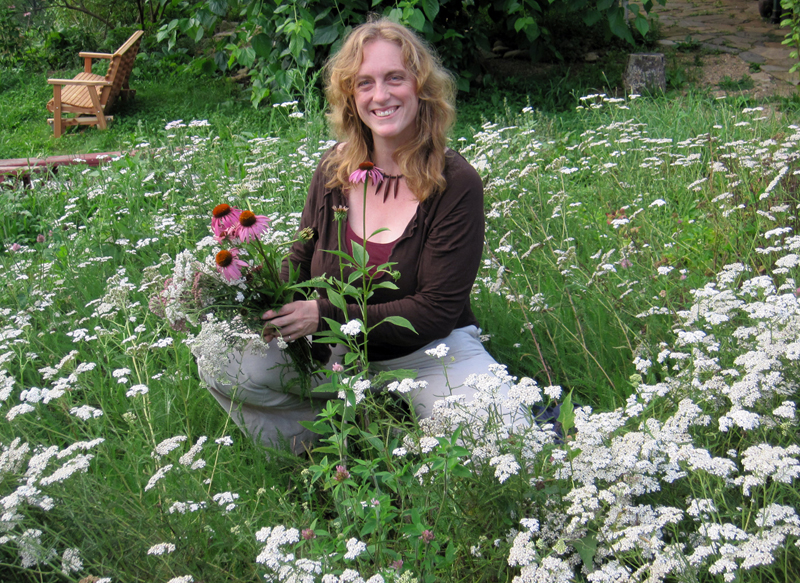Yarrow may not be in your herbal medicine chest yet, but it is one plant you don’t want to do without! It has legendary medicinal qualities — both for humans and the earth — and is quite lovely to boot. So if you’re curious about this extraordinary herb, perhaps a better introduction is in order …
Most of us, including the grateful honeybees, encounter Yarrow in early spring, as it is one of the early plants to flower and lasts well through the summer. Yet, you may have encountered Yarrow much earlier—in your childhood mythological studies. Botanically known as Achillea millefolium, it is named after the Greek God Achilles. One version of the legend is that to protect him from losing blood on the battlefield, his mother dipped him in a vat of this yarrow infusion, all except his infamously vulnerable heels, which were held in order for him to be dipped. The seemingly magical qualities purported by this legend may not be so far-fetched.
Yarrow, also known as nosebleed plant, soldier’s woundwort, and staunchweed, has a long history as a styptic, a substance used to stop bleeding. In fact, when I gashed my foot so badly that I had to step into the bathtub to contain the bleeding, it was yarrow – and my 9 year old son – that came to the rescue. He ran out to our yarrow patch to grab some leaves, which we chewed and placed on my foot as a “spit poultice.” Within 10 minutes the wound had stopped bleeding, and I continued to use the poultices over the next few days to speed healing.
Chewing on yarrow makes your mouth feel dry and puckery, revealing its strong astringent properties — the herbal term for drying or drawing. In addition to regulating bleeding, externally and internally, yarrow also helps prevent infection, has pain relieving properties, and has a mild stimulating effect.
Out West, Yarrow seems to grow wild everywhere, which is helpful, as it is known for improving and stabilizing the soil. Where I live, in the mountains of North Carolina, we mostly see it in gardens, although it does pop up here and there in lawns and roadsides. It is quite lovely, with delicate, feathery leaves and a tall, slender stalk producing a flat-topped cluster of white flowers — the cultivars also include pink and yellow blooms. (With deeply divided leaves and the cluster of white flowers, be certain not to confuse it with the much taller poison hemlock, which is in the Umbelliferae family as opposed to the Daisy family.)
If you don’t have it wild, you can find it at most garden centers, though it is very easy to grow from root division. I like it best as an edging or accent plant in the garden, and love to see the abundance of butterflies and other pollinators it attracts.
Yarrow is also great for the earth — as it is one of the six traditional biodynamic fertilizers in Rodolph Steiner’s system of organic gardening. Planted side-by-side with other plants, it helps replenish minerals like potassium and sulphur as well as attracting beneficial insects. The flowering tops can also be worked with to make a simple fertilizer “tea.” Simply fill a 5-gallon bucket with plant material, add water from hose, and let sit for two weeks!
Yarrow is a plant that is easy to grow, has a beautiful flower, is loved by the honey bee, improves soil quality, offers great medicine and is the story of great legends…what is not to like? I’m glad you two could meet.
Corinna Wood is the Director of Red Moon Herbs, making herbal medicines from fresh, local plants, with a focus on women’s health, since 1994. A gifted teacher, certified herbalist, and fertility awareness trainer, her training includes an extensive apprenticeship with Susun Weed, author, teacher and proponent of the Wise Woman Tradition. Corinna is the founder and director of the Southeast Women’s Herbal Conference, which is now in its 8th year. Dates this year are October 12-14 in Black Mountain, NC. To learn about the Conference, visit sewisewomen.com.
http://www.mountainx.com/images/blogimages/yarrow.jpg




Before you comment
The comments section is here to provide a platform for civil dialogue on the issues we face together as a local community. Xpress is committed to offering this platform for all voices, but when the tone of the discussion gets nasty or strays off topic, we believe many people choose not to participate. Xpress editors are determined to moderate comments to ensure a constructive interchange is maintained. All comments judged not to be in keeping with the spirit of civil discourse will be removed and repeat violators will be banned. See here for our terms of service. Thank you for being part of this effort to promote respectful discussion.